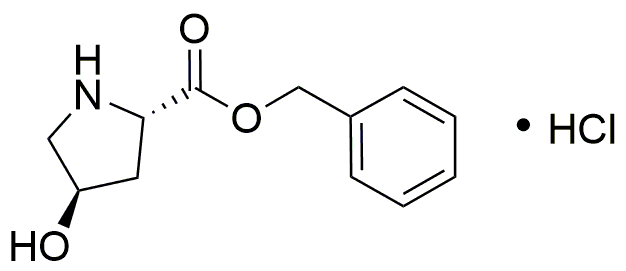trans-L-4-Hydroxyproline benzyl ester hydrochloride is widely utilized in research focused on:
- Pharmaceutical Development: This compound serves as an important intermediate in the synthesis of various pharmaceuticals, particularly those targeting collagen-related disorders, enhancing the development of effective treatments.
- Cosmetic Formulations: Due to its ability to promote collagen synthesis, it is often incorporated into skincare products, helping to improve skin elasticity and reduce the appearance of fine lines.
- Biochemical Research: Researchers use this compound to study its effects on protein folding and stability, providing insights into diseases related to protein misfolding.
- Food Industry: It can be used as a food additive to enhance the nutritional profile of certain products, particularly those aimed at improving joint health.
- Material Science: The compound is explored for its potential in developing biodegradable polymers, contributing to more sustainable material solutions in various applications.
General Information
Properties
Safety and Regulations
Applications
trans-L-4-Hydroxyproline benzyl ester hydrochloride is widely utilized in research focused on:
- Pharmaceutical Development: This compound serves as an important intermediate in the synthesis of various pharmaceuticals, particularly those targeting collagen-related disorders, enhancing the development of effective treatments.
- Cosmetic Formulations: Due to its ability to promote collagen synthesis, it is often incorporated into skincare products, helping to improve skin elasticity and reduce the appearance of fine lines.
- Biochemical Research: Researchers use this compound to study its effects on protein folding and stability, providing insights into diseases related to protein misfolding.
- Food Industry: It can be used as a food additive to enhance the nutritional profile of certain products, particularly those aimed at improving joint health.
- Material Science: The compound is explored for its potential in developing biodegradable polymers, contributing to more sustainable material solutions in various applications.
Documents
Safety Data Sheets (SDS)
The SDS provides comprehensive safety information on handling, storage, and disposal of the product.
Product Specification (PS)
The PS provides a comprehensive breakdown of the product’s properties, including chemical composition, physical state, purity, and storage requirements. It also details acceptable quality ranges and the product's intended applications.
Certificates of Analysis (COA)
Search for Certificates of Analysis (COA) by entering the products Lot Number. Lot and Batch Numbers can be found on a product’s label following the words ‘Lot’ or ‘Batch’.
*Catalog Number
*Lot Number
Certificates Of Origin (COO)
This COO confirms the country where the product was manufactured, and also details the materials and components used in it and whether it is derived from natural, synthetic, or other specific sources. This certificate may be required for customs, trade, and regulatory compliance.
*Catalog Number
*Lot Number
Safety Data Sheets (SDS)
The SDS provides comprehensive safety information on handling, storage, and disposal of the product.
DownloadProduct Specification (PS)
The PS provides a comprehensive breakdown of the product’s properties, including chemical composition, physical state, purity, and storage requirements. It also details acceptable quality ranges and the product's intended applications.
DownloadCertificates of Analysis (COA)
Search for Certificates of Analysis (COA) by entering the products Lot Number. Lot and Batch Numbers can be found on a product’s label following the words ‘Lot’ or ‘Batch’.
*Catalog Number
*Lot Number
Certificates Of Origin (COO)
This COO confirms the country where the product was manufactured, and also details the materials and components used in it and whether it is derived from natural, synthetic, or other specific sources. This certificate may be required for customs, trade, and regulatory compliance.

